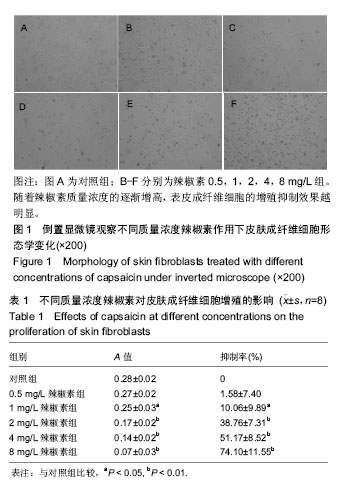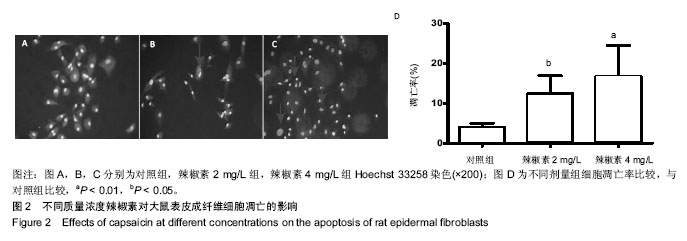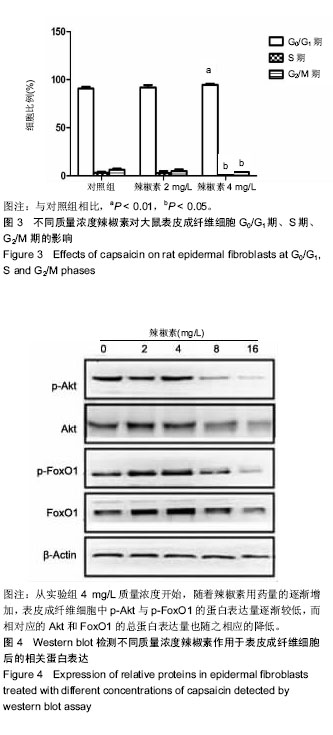中国组织工程研究 ›› 2019, Vol. 23 ›› Issue (7): 1018-1022.doi: 10.3969/j.issn.2095-4344.0574
• 皮肤粘膜组织构建 skin and mucosal tissue construction • 上一篇 下一篇
辣椒素抑制成纤维细胞增殖的作用及其分子机制
周艳星1,彭新生2,侯 敢1,李江滨1,张 华1,周志昆2,周艳芳3
- (广东医科大学,1检验学院,2药学院,3基础医学院,广东省东莞市 523808)
Inhibitory effect of capsaicin on fibroblast proliferation and its molecular mechanism
Zhou Yanxing1, Peng Xinsheng2, Hou Gan1, Li Jiangbin1, Zhang Hua1, Zhou Zhikun2, Zhou Yanfang3
- (1School of Laboratory Medicine, 2School of Pharmacy, 3School of Basic Medicine, Guangdong Medical University, Dongguan 523808, Guangdong Province, China)
摘要:
文章快速阅读:
.jpg) 文题释义:
辣椒素:是辣椒中的主要生物活性成分,它是一种天然的脂溶性含香草酰胺的植物碱,化学结构为8-甲基- N-香草基-6-壬烯基酰胺(C18H27NO3),呈单斜长方形片状无色结晶。辣椒素药理作用十分广泛,具有抗氧化、预防心血管疾病、保护胃肠黏膜、抗癌、镇痛、抗炎止痒等功效,尤其在抑制表皮成纤维细胞方面效果尤为显著。
成纤维细胞:是疏松结缔组织的主要细胞成分,由胚胎时期的间充质细胞(mesenchymal cell)分化而来。成纤维细胞较大,轮廓清楚,多为突起的纺锤形或星形的扁平状结构,其细胞核呈规则的卵圆形,核仁大而明显。根据不同功能活动状态,可将细胞划分成成纤维细胞和纤维细胞,成纤维细胞功能活动旺盛,细胞质嗜弱碱性,具明显的蛋白质合成和分泌活动,在一定条件下,它可以实现跟纤维细胞的互相转化。成纤维细胞对不同程度的细胞变性、坏死和组织缺损以及骨创伤的修复有着十分重要的作用。
文题释义:
辣椒素:是辣椒中的主要生物活性成分,它是一种天然的脂溶性含香草酰胺的植物碱,化学结构为8-甲基- N-香草基-6-壬烯基酰胺(C18H27NO3),呈单斜长方形片状无色结晶。辣椒素药理作用十分广泛,具有抗氧化、预防心血管疾病、保护胃肠黏膜、抗癌、镇痛、抗炎止痒等功效,尤其在抑制表皮成纤维细胞方面效果尤为显著。
成纤维细胞:是疏松结缔组织的主要细胞成分,由胚胎时期的间充质细胞(mesenchymal cell)分化而来。成纤维细胞较大,轮廓清楚,多为突起的纺锤形或星形的扁平状结构,其细胞核呈规则的卵圆形,核仁大而明显。根据不同功能活动状态,可将细胞划分成成纤维细胞和纤维细胞,成纤维细胞功能活动旺盛,细胞质嗜弱碱性,具明显的蛋白质合成和分泌活动,在一定条件下,它可以实现跟纤维细胞的互相转化。成纤维细胞对不同程度的细胞变性、坏死和组织缺损以及骨创伤的修复有着十分重要的作用。
.jpg) 文题释义:
辣椒素:是辣椒中的主要生物活性成分,它是一种天然的脂溶性含香草酰胺的植物碱,化学结构为8-甲基- N-香草基-6-壬烯基酰胺(C18H27NO3),呈单斜长方形片状无色结晶。辣椒素药理作用十分广泛,具有抗氧化、预防心血管疾病、保护胃肠黏膜、抗癌、镇痛、抗炎止痒等功效,尤其在抑制表皮成纤维细胞方面效果尤为显著。
成纤维细胞:是疏松结缔组织的主要细胞成分,由胚胎时期的间充质细胞(mesenchymal cell)分化而来。成纤维细胞较大,轮廓清楚,多为突起的纺锤形或星形的扁平状结构,其细胞核呈规则的卵圆形,核仁大而明显。根据不同功能活动状态,可将细胞划分成成纤维细胞和纤维细胞,成纤维细胞功能活动旺盛,细胞质嗜弱碱性,具明显的蛋白质合成和分泌活动,在一定条件下,它可以实现跟纤维细胞的互相转化。成纤维细胞对不同程度的细胞变性、坏死和组织缺损以及骨创伤的修复有着十分重要的作用。
文题释义:
辣椒素:是辣椒中的主要生物活性成分,它是一种天然的脂溶性含香草酰胺的植物碱,化学结构为8-甲基- N-香草基-6-壬烯基酰胺(C18H27NO3),呈单斜长方形片状无色结晶。辣椒素药理作用十分广泛,具有抗氧化、预防心血管疾病、保护胃肠黏膜、抗癌、镇痛、抗炎止痒等功效,尤其在抑制表皮成纤维细胞方面效果尤为显著。
成纤维细胞:是疏松结缔组织的主要细胞成分,由胚胎时期的间充质细胞(mesenchymal cell)分化而来。成纤维细胞较大,轮廓清楚,多为突起的纺锤形或星形的扁平状结构,其细胞核呈规则的卵圆形,核仁大而明显。根据不同功能活动状态,可将细胞划分成成纤维细胞和纤维细胞,成纤维细胞功能活动旺盛,细胞质嗜弱碱性,具明显的蛋白质合成和分泌活动,在一定条件下,它可以实现跟纤维细胞的互相转化。成纤维细胞对不同程度的细胞变性、坏死和组织缺损以及骨创伤的修复有着十分重要的作用。摘要
背景:研究报道辣椒素具有抑制纤维化作用,可抑制增生性成纤维细胞增殖能力和胶原合成能力,但是辣椒素抑制成纤维细胞增殖的确切机制尚未明确。
目的:探讨辣椒素对抑制表皮成纤维细胞增殖的影响及其相应的分子作用机制。
方法:体外原代培养获得新生SD大鼠表皮成纤维细胞,采用不同质量浓度辣椒素(0.5,1,2,4,8 mg/L)作用24 h后,并以不加辣椒素为阴性对照组。倒置显微镜观察表皮成纤维细胞形态变化和MTT法检测皮肤成纤维细胞的存活率及其IC50值,用Hoechst 33258染色法和AnnexinV-FITC/PI双染法观察和检测其细胞凋亡;采用流式细胞术检测表皮成纤维细胞的细胞周期;Western blot 检测不同质量浓度的辣椒素(0,2,4,8,16 mg/L)诱导大鼠表皮成纤维细胞FoxO1、p-FoxO1、Akt、p-Akt蛋白表达改变。
结果与结论:①随着辣椒素质量浓度的增高,表皮成纤维细胞的细胞存活率逐渐降低,且呈现浓度依赖性,其IC50值为3.55 mg/L;②与对照组相比,辣椒素作用于表皮成纤维细胞24 h后,表皮成纤维细胞阻滞在G1期而且凋亡率增加,同时能降低p-Akt及p-FoxO1的蛋白表达水平;③结果说明,辣椒素能抑制皮肤成纤维细胞的增殖、促进细胞凋亡,且呈现浓度依赖效应,Akt-FoxO1信号通路可能参与了辣椒素的抑制增殖效应。
中国组织工程研究杂志出版内容重点:组织构建;骨细胞;软骨细胞;细胞培养;成纤维细胞;血管内皮细胞;骨质疏松;组织工程
ORCID: 0000-0001-7109-2748(周艳星)
中图分类号:



.jpg) 文题释义:
辣椒素:是辣椒中的主要生物活性成分,它是一种天然的脂溶性含香草酰胺的植物碱,化学结构为8-甲基- N-香草基-6-壬烯基酰胺(C18H27NO3),呈单斜长方形片状无色结晶。辣椒素药理作用十分广泛,具有抗氧化、预防心血管疾病、保护胃肠黏膜、抗癌、镇痛、抗炎止痒等功效,尤其在抑制表皮成纤维细胞方面效果尤为显著。
成纤维细胞:是疏松结缔组织的主要细胞成分,由胚胎时期的间充质细胞(mesenchymal cell)分化而来。成纤维细胞较大,轮廓清楚,多为突起的纺锤形或星形的扁平状结构,其细胞核呈规则的卵圆形,核仁大而明显。根据不同功能活动状态,可将细胞划分成成纤维细胞和纤维细胞,成纤维细胞功能活动旺盛,细胞质嗜弱碱性,具明显的蛋白质合成和分泌活动,在一定条件下,它可以实现跟纤维细胞的互相转化。成纤维细胞对不同程度的细胞变性、坏死和组织缺损以及骨创伤的修复有着十分重要的作用。
文题释义:
辣椒素:是辣椒中的主要生物活性成分,它是一种天然的脂溶性含香草酰胺的植物碱,化学结构为8-甲基- N-香草基-6-壬烯基酰胺(C18H27NO3),呈单斜长方形片状无色结晶。辣椒素药理作用十分广泛,具有抗氧化、预防心血管疾病、保护胃肠黏膜、抗癌、镇痛、抗炎止痒等功效,尤其在抑制表皮成纤维细胞方面效果尤为显著。
成纤维细胞:是疏松结缔组织的主要细胞成分,由胚胎时期的间充质细胞(mesenchymal cell)分化而来。成纤维细胞较大,轮廓清楚,多为突起的纺锤形或星形的扁平状结构,其细胞核呈规则的卵圆形,核仁大而明显。根据不同功能活动状态,可将细胞划分成成纤维细胞和纤维细胞,成纤维细胞功能活动旺盛,细胞质嗜弱碱性,具明显的蛋白质合成和分泌活动,在一定条件下,它可以实现跟纤维细胞的互相转化。成纤维细胞对不同程度的细胞变性、坏死和组织缺损以及骨创伤的修复有着十分重要的作用。